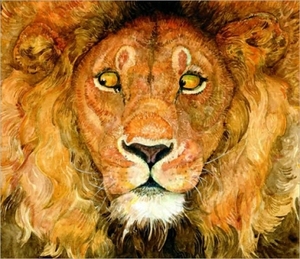- This page was last modified on 17 October 2025, at 10:18. Suggest an edit.
The Lion & the Mouse facts for kids
This article is about The Lion and the Mouse (disambiguation). For other uses, see The Lion & the Mouse (disambiguation).

Front cover
|
|
| Author | Jerry Pinkney |
|---|---|
| Illustrator | Jerry Pinkney |
| Country | United States |
| Genre | Children's picture book |
| Publisher | Little, Brown Books for Young Readers |
|
Publication date
|
September 1, 2009 |
| Pages | 40 |
| ISBN | 0-316-01356-0 |
| OCLC | 263604760 |
| LC Class | PZ8.2.P456 Li 2009 |
The Lion & the Mouse is a special picture book from 2009. It was created by Jerry Pinkney. This book tells one of Aesop's famous fables. It's about a powerful lion and a tiny mouse. The story shows how even the smallest creature can help the strongest.
In the book, a lion spares a mouse's life. Later, the lion gets caught in a trap. The little mouse then helps the lion escape. This book is almost entirely without words. It uses beautiful pictures to tell the story. This was Jerry Pinkney's first wordless picture book. He had told this fable before in his 2000 book, Aesop's Fables.
Jerry Pinkney won the Caldecott Medal for his amazing artwork in this book. He was the first African American to receive this award. People really liked his realistic drawings. They also praised how well he showed the story's setting. The book's cover, with just the lion and mouse, was also highly praised.
Contents
Creating the Book
Jerry Pinkney had already shared this story once before. He included it in his collection of Aesop's Fables in 2000. When making this new book, Pinkney wanted to do two things. He wanted to retell a classic tale. He also wanted to show the African-American experience.
Pinkney also aimed to make the fable exciting. He wanted it to be more than just a moral lesson. This story was his favorite fable. He felt that the lion and mouse characters were easy for kids to relate to. Pinkney thought a wordless version made sense. He had seen other short versions of the story.
He first planned to add words to the book. But after finishing the pictures, he realized it could be wordless. He showed his editor two versions. One had animal sounds like "roar" or "squeak." The other had no sounds. They both agreed the sounds made the story better. Pinkney said these sounds gave the story "continuity and motion and energy." He felt it was "nature speaking."
Pinkney hoped the book would make readers think about its African setting. This place is called the Serengeti. He wanted people to care about and protect this important area.
Publication Details
The book was released on September 1, 2009. It was published by Little, Brown Books for Young Readers. An audio version came out in 2011. It had sounds and music by Sazi Dlamini. This audio book is meant to be enjoyed while looking at the pictures.
What Happens in the Story
This book has almost no words. The only words are the sounds the animals make. The story starts at dawn, as the sun rises. A small mouse escapes from several animals that want to catch it. Then, the mouse meets a huge lion.
The lion decides to let the mouse go free. Later in the story, some hunters come along. They capture the lion in a strong net. The little mouse then comes to help. It chews through the ropes of the net. This frees the lion. After that, the lion and the mouse become friends.
Art and Design
Pinkney used special art tools for the book. He used "pencil, watercolor, and colored pencils on paper." This method helped him add many "pleasing details." This is what The Horn Book Magazine said about the art.
The book's front cover is unique. It has no words, just a picture of the lion. The back cover shows the mouse. When you open the book, the mouse and lion seem to look at each other. The pictures show the characters' personalities. The lion is powerful. The mouse is curious and watchful. Close-up drawings of their body parts help show these traits.
The pictures of the Serengeti are very detailed. They show the animals in the correct sizes compared to each other. The drawings are from a human's eye level. But they also make you look closer. For example, you might look down to see the tiny mouse. The animals show feelings without looking like humans. Pinkney also used panels, like in a silent movie. This helped show the speed and excitement of the action. Other design choices, like using white space, also made the book better.
Story Message and Themes
Pinkney made this book almost wordless. This helped him turn a short fable into a longer story. Many people said this style needed readers to use their imagination. It made them really get into the story. Wendy Lukeheart from School Library Journal said the lack of words made it "a slower, subtle, and ultimately more satisfying read."
The book's main idea is how the strong can sometimes hurt the weak. But it also shows how the weak can help the strong. In this wordless book, the mouse cannot talk to the lion. Yet, the story still shares the original fable's message. It shows that being "meek" or "mighty" depends on how you look at it.
The lion and the mouse use their different strengths and weaknesses. They learn to work together and become friends. Pinkney also wanted to explore the story's setting. He also wanted to show the characters' families. The "temptation, danger, and choice" the characters face might remind some of a Garden of Eden-like place, according to Horn Book.
